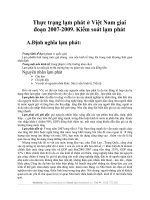Adirondacks CEN 514 2007
Bạn đang xem bản rút gọn của tài liệu. Xem và tải ngay bản đầy đủ của tài liệu tại đây (5.27 MB, 55 trang )
Adirondack Geology:
Old Rocks
and
New Mountains:
Glenn A. Richard
The Adirondacks are a dome of
old rock (1.1 billion years),
surrounded by much younger
rock (less than 600 million
years)
Relief Map of Adirondacks
Map of Streams and Lakes
Surface water elevations
are primarily controlled by
underlying bedrock
elevations, rather than the
type of bedrock.
Radial drainage pattern:
Streams flow primarily
outward from the center
toward the edge.
However, drainage in the
Adirondacks is also
controlled by faults.
Roadless areas are
undeveloped. ~43% of 6
million acre Adirondack
Park (created in 1892) is
owned by the state and
belongs to the Forest
Preserve (created in
1885).
Roads
Mount Marcy, highest point in New York (5344’), from Haystack.
Predominant rock type is metanorthosite (Mineralogy: mostly blue
labradorite feldpar (high in Ca, some Na, low in K), with some
pyroxene).
Shore of Lake Champlain (elevation 95 feet) from eastern
Adirondacks. Lowest elevation in Adirondacks.
Haystack from Marcy – July 2, 2001. Rugged topography caused by
faulting, uplifting, erosion by water and glacial ice.
Gothics – September 2, 2001- Note steep rockslides
Picea rubens and Abies balsamea just below tree line on
Haystack, third highest peak in the state at 4960’.
Cross section of Earth
Layers of the Earth:
Diagram by
Keelin Murphy
•Inner Core
•Outer Core
•Mantle
•Crust
Crust and very upper mantle are
hard rock, called lithosphere.
Lithosphere divided into tectonic plates. Plates are in motion – several
centimeters per year – PLATE TECTONICS
Orogeny: Collision of plates can build mountains (Example: Himalayas
now rising due to current collision of Indian and Asian plates).
Plate Boundaries
Transform: San
Andreas Fault
Divergent: East
Pacific Rise
Convergent: West
Coast of South
America -Andes
forming here
Diagram by
Keelin Murphy
1.3 Billion Years Ago: Pre-Grenville Ocean
Fossil stromatolite (blue-green alga, 1.3 bya) near Balmat in western
Adirondacks. From Pre-Grenville Ocean prior to Grenville Orogeny .
1.1 Billion Years Ago: Grenville Orogeny
Metanorthosite (intruded about 1.15 bya) with labradorite crystal on
Noonmark. Smaller amounts of pyroxene are present.
Grenville Orogeny metamorphosed the rock about 1.1 bya while it
formed the Grenville Supercontinent and the Grenville Mountains.
Boudinage in migmatite, northwestern Adirondacks
formed during Grenville Orogeny 1.1 bya
650 Million Years Ago: Grenville Supercontinent Breaks Up
Lake Placid from Whiteface. Shape is controlled by a group of faults
that formed about 650 million years ago, when Grenville
Supercontinent split up.
Colden, Avalanche Pass, Algonquin, Indian Pass, Wallface.
Passes are valleys formed along faults.
Faulting helps to create
valleys and basins for
streams and lakes.
Lake Placid from Whiteface. Shape is controlled by some
of the faults that formed about 650 million years ago.
Diabase dike (650 mya) in western Adirondacks intruded
during breakup of Grenville supercontinent.
500 Million Years Ago: A Warm Shallow Sea
Ripple marks on Potsdam Sandstone (500 mya), Ausable Chasm display.
Formed in warm shallow sea. Potsdam sandstone probably covered
Adirondacks and was eroded from central portions after later uplift.
Beginning 60 to 15 Million Years Ago: Adirondack Mountains Form
Great Range from Noonmark – Adirondacks rising since 60 to 15
million years ago for uncertain reasons. Some have attributed uplift
to a hot spot, but there is not much evidence for that.
Beginning 1.6 Million Years Ago: Continental and Alpine Glaciation
Glacial erratic near Debar Mountain in northern Adirondacks
Potsdam Sandstone left by ice sheet on Poke-O-Moonshine
Au Sable Chasm with Potsdam Sandstone. Au Sable
River has cut into the sandstone as uplift occurs.
Heart Lake from Mount Jo. Some consider it to be a glacial kettle.
Snow on Saint Regis Mountain with fall color at lower elevations,
shows climate variation with elevation.








